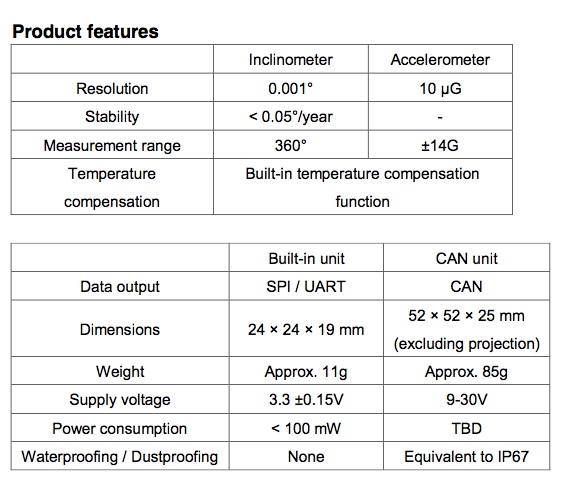SAN JOSE, CA – November 5, 2012 – Epson Electronics America (EEA) today announced two new compact inclinometers and accelerometers (three-axis sensor units) for different industrial and aerospace applications.These products provide stable monitoring for extended periods of time with a resolution of 0.001 degrees (inclinometer) and 10 ?G (accelerometer). Epson will begin shipping samples in January 2013 and plans to begin volume production within the year.Limited test samples are available now for select customers.
Today these types of sensors are widely used in the construction and civil engineering industries to monitor horizontal and vertical planes in skyscrapers and other large structures, as well as to measure structural distortion and changes over time that occur due to vibration and seismic activity.However, the high-precision inclinometers and accelerometers currently available are extremely expensive, large and heavy, presenting significant problems during usage.Epson’s new devices answer the industry’s call for small, power-efficient sensors that keep down the total cost of constructing monitoring systems yet offer the long-lasting accuracy and stability their projects require.
“To meet the customer needs we drew on our unique strength in QMEMS1 fabrication technology to develop a new quartz accelerometer that is both highly accurate and stable,” said Toshihiko Kano, General Manager of Epson’s M Project. “We combined this accelerometer with semiconductor and software technology to form high-performance inclinometers and accelerometers (three-axis sensor units) for a wide range of applications.We will supply these inclinometers and accelerometers as built-in models and as CAN2-compliant waterproof anddustproof models that can be used in a variety of applications.”
These new products make it easy to build a flexible monitoring system that will satisfy industrial performance requirements without exceeding budgets.They can also easily be used to realize multi-node and synchronous measurement systems.By using a digital interface, Epson has enabled customers to quickly build monitoring systems with superior noise performance over very long distances.

Epson plans to demonstrate these products at Electronica 2012, an international trade fair for electronic components, systems and applications to be held in Munich, Germany, from November 13-16. Epson’s booth will be in Hall A4, Booth #224.
Epson has identified sensing as an important growth business in its long-range corporate vision. The company will thus continue to leverage its crystal-based QMEMS technology in the sensing of quantities such as time, pressure, and angular velocity, driving further advances in convergence with semiconductor and software technologies to provide customers with a wide array of solutions they know they can trust.
1.QMEMS is a combination of “Quartz,” a crystalline material with excellent characteristics such as excellent frequency stability and high precision, and “MEMS” (micro electro mechanical system). QMEMS devices, produced via a micro-fabrication process on a Quartz material instead of on a semiconductor material like MEMS, offer high performance in a compact package. QMEMS is a registered trademark of Seiko Epson Corporation.
2.CAN (Controller Area Network): A network protocol used for automotive and industrial applications
About Epson Electronics America, Inc.
Epson Electronics America, Inc. (EEA), is a subsidiary of Japan-based Seiko Epson Corporation (SEC) and is responsible for sales, marketing and engineering of the product lines of SEC’s Microelectronics Device Division in the America’s.EEA provides a wide array of timing and frequency control products, integrated circuits, sensing device and system solutions for customer products and applications that require high levels of accuracy, reliability, stability, energy efficiency and compact design.Based in San Jose, California, the EEA Group has four regional offices, more than 40 sales offices in the U.S., and a growing network of exclusive distributors.






